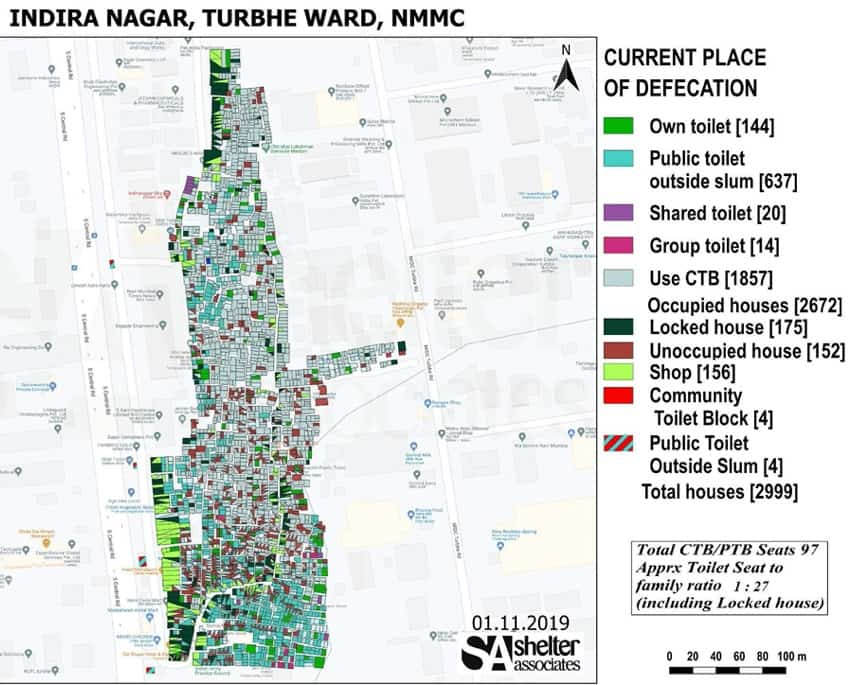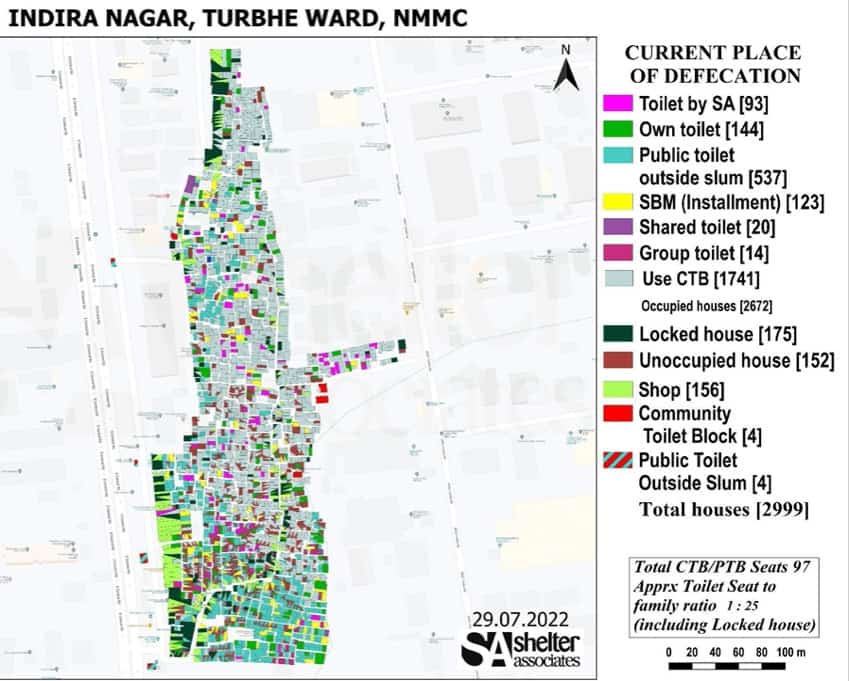Shelter Associates
By implementing a comprehensive sanitation project in the Indira Nagar slum in Turbhe, Navi Mumbai, we worked to understand the knowledge, attitudes and sanitation practices of residents of the community, developed communication materials from the findings of our survey, conducted community mobilisation activities for waste segregation at source, a needs assessment of the existing sanitation situation of households, and helped build the community sanitation and individual household toilets we predominantly work on using a one-home-one-toilet approach.
The Indira Nagar slum, in which some 3,000 families live, is situated on a hill slope with no supply of sewer drainage facilities. Less than 1 in 10 households had a private toilet there, and only 40 public toilet seats and 57 community toilet seats had been made available to the other residents, for a toilet-seat-to-person ratio of around 1 for every 108 people living there.
The municipal corporation responsible had contracted an agency to collect segregated waste from 2,000 households every day in the slum. Despite their efforts, the agency could not achieve even half the contract target, causing mounting sanitation problems in the area.
To further ensure ecosystem protection and sustainability, especially in view of the Sustainable Development Goals (SDGs) 6.2 and 6.3, our solution incorporated ecological health with the needs of families and individuals in the community. Our intervention increased drainage supply coverage in the municipal corporation from a mere 13 to 46% area. This enabled the building of nearly 4,000 toilets with safely managed systems for the healthy disposal of human waste.
We also encourages behaviour change through intense community mobilisation which led to a committed and sustainable change among local residents and the waste collection agency in regard to the safe disposal of household waste, which would otherwise littered the corners around the slum.
We began by mapping the area using Google Earth and QGIS to create digitised maps of slum households that included the available infrastructure as well as results gathered from a rapid survey to yield information about the community, namely, households with a toilet, and those that contributed to waste collection. The digitised maps were validated by the municipal corporation’s slum, drainage, water and solid waste management departments and have been made available on the corporation’s website for others to use for free.
In mobilising the community, we found that the linear use-and-throw approach was contributing to poor sanitation, and so we have designed activities to enhance awareness of the ecological impacts of open dumping, creating specific action plans for the Indira Nagar community. Local volunteers were trained to lead the mobilisation efforts, ensuring community participation in developing and implementing mobilisation activities.
To build the toilets, Shelter Associates provided architectural design support to overcome the challenge of building a 14 m2 toilet in these homes. Given the absence of a drainage system, innovative septic tanks were incorporated to prevent the open release of untreated waste, protecting the soil and water.
We also developed a cost-sharing model where each stakeholder ensures the availability of infrastructure and resources as needed for the project, and we provide the construction material and design support. The families invest in constructing the toilet, and the municipal corporation lays the necessary drainage lines. Our robust supply chain mechanism ensures the doorstep delivery of construction material of the required quality, while the families who invest from their pockets have the toilet constructed according to the architectural support we provide.
Our experience with the increment based approach used in the Indian government’s Swachh Bharat (Clean India) Mission showed that households who could not afford timely investments experienced a delay of three months to a year in getting toilets constructed. Moreover, leveraging corporate social responsibility funds to provide quality construction material has been one of our successful strategies.
To document the project and monitor progress, community volunteers and Shelter Associates made use of granular spatial data and end-to-end monitoring systems to track activity progress, ensure the participation of all community members in activities, in toilet construction and toilet use, and to ensure the project was completed in time. Individual household factsheets were also generated and shared with donors and officials to maintain accountability and transparency.
Results
We built 93 individual household toilets in Indira Nagar which use the innovative septic tanks, reducing the incidence of open defecation from 30 to 0.8%, and addressing the overreliance on public and community toilet seats. We reduced the toilet-seat-to-person ratio to around 1 per 100 people, and with the support of philanthropy we can scale our project to reduce the ratio to an acceptable norm.
In waste collection, a pre-intervention survey showed that waste collectors only attended to the easily accessed areas by the road, neglecting the households situated further off in the internal lanes. The absence of granular spatial data had made it difficult to monitor the extent of solid waste collection in the slum. Our digitised maps of the area improved the solid waste collection coverage from 790 to 1,525 households in just over a month. The intervention also mobilised individuals and families to contribute to waste collection efforts, enabling the segregation of waste at source. In terms of sanitation, the health effects of toilet provision and comprehensive sanitation coverage are well documented.
These interventions have led to the provision of safely managed sanitation in the community. The management of waste and sewage prevented contamination of soil and water by household or personal waste, thus mitigating the effects of ecosystem harm. All households adopted handwashing practices, and the prevalence of urinary tract infections decreased from 23% to 13%. The change in waste segregation and collection practices had an overall effect on the cleanliness of the surroundings and led to improved hygienic conditions in the Indira Nagar slum.
Households coloured blue belong to those segregating waste and handing it to waste collectors (12 days)
Opportunities
The project can be scaled to any informal or marginalised slum settlement in the country. We are providing support to 7 cities in Maharashtra and have facilitated the use of over 26,000 toilets in a one-house-one-toilet model driven by data.
We make our projects sustainable by
- Connecting with communities at multiple levels, bridging the gap between urban local bodies and communities. We engage with community stakeholders for our data, mapping and infrastructure requirements and planning for the same. Our data is shared in the public domain. We work closely with community volunteers, sanitation staff and Anganwadi (childcare) workers to leverage the data and sensitise urban local bodies on community needs.
- Our mobilising activities create sustained change in the community. We create development communication tools to educate slum-resident communities effectively, with stakeholder engagement to bring awareness and a positive change in actions. We use self-developed information, education and communication (IEC) materials such as sanitation-themed board games, flipcharts, posters, corner meetings, street plays and more to sensitise communities.
- Data brings clarity to the communities and to urban local bodies by identifying the gaps in service provision to achieve an equitable resource distribution leading to good governance practices in the community. Granular spatial data makes it easy to monitor waste management, while community mobilisation helps sensitise local stakeholders to segregate waste at home, for instance, or to participate in waste management activities.
- Volunteers are trained to conduct door-to-door surveys using digital apps and in reading maps of slum households. As development communicators, they disseminate various IEC materials, and thus gain training in digital tools, data utilisation and inference, project planning, and in mobilising their communities.
The challenges faced in upscaling relate to certain structural inadequacies in the municipal corporations, and a lack of planning, community involvement, innovation and usable data.
We intend to scale this project to the remaining accessible households in the Indira Nagar community, and to cater to the needs of slums in the area. We have data already on the availability and sources of water for these households, and would work with the municipal corporation to lay water lines in the community to facilitate individual, metered water connections to each household in future, thus making the equitable allocation of water resources possible, and meeting the essential needs of the community as mandated by the Swachh Bharat Mission.
Septic tank installation and connection to the sewer chamber
























